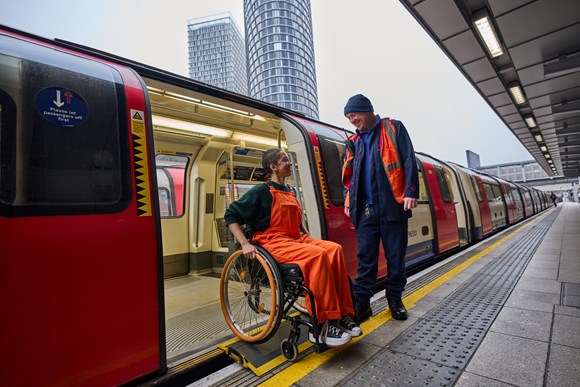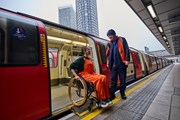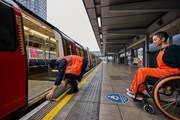
Wednesday 16 Nov 2022
TfL Press Release - TfL publishes its step-free access consultation results as it launches a trial of a brand new bridging device on the Jubilee line

PN-116
- More than 5,500 responses to step-free access consultation
- Consultation feedback includes the types of stations customers would like TfL to make step-free, as well as broader accessibility improvements such as toilet provision and accessible signage
- TfL launches first-of-its kind bridging device trial on the Jubilee line to boost accessibility on the transport network
Transport for London (TfL) has today published the results of its step-free access consultation as it launches a trial of a new bridging device as part of its ongoing work to make the capital’s network more accessible and inclusive.
The specially commissioned bridging device has been designed to provide additional support, comfort and reassurance to customers at step-free stations where there remains a small gap between the platform and train carriage.
Customers will be invited to try the new bridging device at eight Jubilee line stations until February 2023 - including London Bridge, Canary Wharf and Green Park. Customers can just turn up at any one of the stations in the trial to request to use the bridging device and station staff will be able to deploy the device. They are also available to assist customers wanting to get off the train at one of the trial stations, by requesting for a member of staff to be waiting with the device. The bridging device is the same width as the boarding ramps already in extensive use across the network but is only 200mm in length. Customers who have used the device are invited to provide comments about their experience including suggesting a name for it.
If the trial is successful, TfL will consider extending the use of the bridging device across the London Underground and wider TfL network as it continues working to make the capital’s network more accessible and inclusive.
From November 2021, TfL ran a 14-week public consultation looking into how it could best shape the future of step-free access on the Tube when suitable funding is identified.
More than 5,500 people took part in the public consultation, with the headline responses including that 66 per cent of public respondents would use the Tube more if there were more step-free stations. 880 people who completed the consultation said they do not currently use the Tube, but 80 per cent of these said they would use it if it was more accessible to them.
Mark Evers, Transport for London’s Chief Customer Officer, said: “Making our transport network more accessible and inclusive is a top priority for us, as we know that a more accessible public transport network benefits everyone. The response to the consultation shows how important accessibility is for encouraging more people to use public transport. The bridging device has been designed to improve customers’ confidence and experience of using the network and I hope as many people as possible try it out during the trial period.
“The results of the step-free access consultation have already been embedded in our short-term work to improve accessibility and will continue to shape our future goals.”
Seb Dance, Deputy Mayor for Transport said: “We are working hard to improve step-free accessibility across the TfL network in order to build a better, fairer London for everyone. This new trial is one example of how we are seeking out innovative solutions to enhance step-free access. It is also vital that our accessibility plans are informed by disabled and older customers and I am delighted that we have had such a great response to the consultation.
“I’m pleased that there are now more than 200 step-free stations across the TfL network are step-free and with the recent opening of Bond Street station, all 41 Elizabeth line stations have step-free access, with the majority of central stations on the line being step-free from street to train. There is still work to do, and we will ensure that this feedback shapes how we prioritise and deliver step-free stations into the future.”
Other key findings in the consultation include:
- Stations that interchange with other transport services were a clear priority for respondents, along with stations that are within easy reach of hospitals and healthcare services
- 69 per cent of public respondents felt that it would be best to prioritise step-free access at a combination of some smaller and medium sized Tube stations and part of a complex station (as opposed to just one complex station; a few medium stations; or more smaller stations)
- 63 per cent of respondents preferred for TfL to ‘plug the gaps’ where there is a large area with few step-free stations rather than create ‘hubs’ by filling in the gaps where most of an area is already step-free
- More than half said their usage of the Tube would expand (52 per cent) and that their journeys would be made easier (68 per cent) and less stressful (64 per cent) if their most important Tube stations were made step-free
TfL is delivering step-free improvements across the whole transport network as part of its commitment to increasing accessibility and inclusion. The consultation results also outlined other aspects of the network that customers believe could be improved including toilet provision, accessible signage, staff boarding ramp training and walking distances between step-free routes. TfL is working to address these, including:
- TfL has assigned budget to improve toilets that are most in need of repair. Analysis is also being undertaken to assess where there are gaps in accessible toilet provision, especially at stations with existing step-free access
- Accessible signage to improve step-free wayfinding in stations has been installed at 16 London Underground, 11 Elizabeth line and two DLR stations, with more to follow shortly
- Staff at stations where boarding ramps are available have had additional briefings to ensure they can assist customers requiring ramp assistance. TfL continues to provide station staff with essential accessibility training, with a view to refresh existing training materials
- TfL is adding interchange walking time to its online Journey Planner. This displays as a stage on the journey, for example ‘interchange from Victoria to Central line – 5 minutes’
The step-free access consultation, which ran from November 2021 to February 2022, was developed with input from TfL's Independent Disability Advisory Group as well as a number of organisations TfL engages with that represent older people, disabled people and parents and carers.
John McGeachy, Age UK London’s Senior Campaigns Officer, said: “These consultation results provide a powerful illustration of the potential that step-free stations have to the transform lives of older and disabled Londoners as well as many others. Increasing the number of step-free stations on the Underground network will open the capital up to people that have faced too many barriers for too long. When greater accessibility means more people can go to the places they want to go to everyone benefits. Step-free stations are a priority and we look forward to seeing work start on new projects as soon as possible.”
TfL’s funding situation as a result of the pandemic has affected progress of step-free projects. However, TfL will use the results from the consultation to help it understand which stations would be good candidates for future step-free access work. External funding will be critical to the ongoing delivery of more step-free schemes due to the financial pressures that TfL continues to face. TfL will continue to work with third parties and developers to identify funding. In September, TfL submitted a list of 20 stations for consideration for the Department for Transport’s Access for All programme, which provides funding to make stations more accessible. TfL will also look to support the delivery of step-free improvements, where possible, as part of its wider commercial development programme at stations and its planned property developments across London.
TfL is currently working with third parties to deliver step-free access at Knightsbridge and Paddington (Bakerloo line only). The ongoing station upgrade works at Bank will also deliver step-free access to the Northern line and improved step-free access to the DLR as well as a new accessible toilet in the ticket hall. The current proposed designs for the redeveloped Euston station, which are being designed, funded and delivered as part of High Speed 2, would also provide step-free improvements to Euston and Euston Square Tube and rail stations.
There are now more than 200 step-free stations across the TfL network. These include: 92 Tube stations, 62 London Overground stations, all DLR stations and Tram stops. All 41 Elizabeth line stations have step-free access, with the majority of central stations being step-free from street to train.
Contact Information
TfL Press Office
Transport for London
0343 222 4141
pressoffice@tfl.gov.uk
Notes to editors
- The trial can be found at the following eight stations on the Jubilee line:
- London Bridge
- North Greenwich
- Green Park
- Canary Wharf
- Bermondsey
- Canning Town
- Canada Water
- Stratford
- Customers are encouraged to submit their feedback on the trial here
- All London Underground and London Overground stations offer a Turn-up-and-go service for customers needing assistance with their journeys. Customers using this service do not need to pre-book assistance and can request help on arrival at the station. TfL staff are trained to advise and assist disabled customers and are ready to help support journeys if needed. More information can be found on the TfL website: tfl.gov.uk/transport-accessibility/help-from-staff
- TfL has recently updated the Accessible Travel in London leaflet to reflect a range of services and support available on the network. The leaflet is available online and in easy read version: https://content.tfl.gov.uk/accessible-travel-web.pdf
- A map showing TfL station toilet facilities is available here: https://content.tfl.gov.uk/toilets-map.pdf
- TfL's Please Offer Me a Seat badge is free of charge and has been given to more than 100,000 disabled people and those with invisible conditions since 2017. To request one, please visit https://tfl.gov.uk/transport-accessibility/please-offer-me-a-seat
- A range of Tube maps and guides including audio, large print and step-free versions are available here: https://tfl.gov.uk/forms/12387.aspx
- TfL's free travel mentoring service supports disabled people gain confidence in using public transport. For more information visit tfl.gov.uk/transport-accessibility/learn-to-use-public-transport
- TfL, together with British Standards Institute have been part of pioneering work in creating and developing new design guidelines and standards called PAS 6463 for a more inclusive and accessible built environment for the neurodiverse





